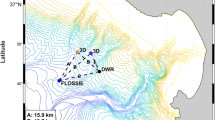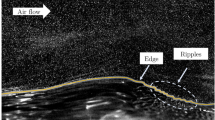Abstract
Recent research indicates that non-orthogonal sonic anemometers underestimate vertical wind velocity and consequently eddy-covariance fluxes of mass and energy. Whether this is a general problem among all non-orthogonal sonic anemometers, including those calibrated for flow-shadowing effects, is unknown. To investigate this, we test two sonic anemometer designs, orthogonal (3Vx-probe, Applied Technologies, Inc.) and non-orthogonal (R3-50, Gill Instruments, Ltd.), in a series of field manipulation experiments featuring replicate instruments mounted in various orientations, and use a Bayesian analysis to determine the most likely posterior correction to produce equivalent measurements. The 3Vx-probe experiment was conducted on a 24-m scaffold at the Glacier Lakes Ecosystem Experiments Site (GLEES), Wyoming, USA AmeriFlux site while R3-50 anemometer experiments were conducted at the GLEES field site and on a 2.9-m scaffold at the Pawnee National Grassland, Colorado, USA. Without applying a shadowing correction to the 3Vx-probe, the posterior correction significantly increases the standard deviation of the horizontal velocity component by 5–15% (95% Bayesian credible interval) but without a significant change in the horizontal temperature flux; with the shadowing correction applied neither of these have significant changes. Similarly, for the R3-50 GLEES experiment, the standard deviation of the vertical velocity and vertical temperature flux significantly increase by 13–18% and 6–10% (95% credible intervals); results from the Pawnee experiment are contradictory and inconclusive. The reason for the underestimated vertical velocity is undetermined, though a mathematical by-product of the non-orthogonal geometry is that small systematic measurement biases can become large uncertainties in the vertical velocity. This could affect all non-orthogonal designs.












Similar content being viewed by others
References
Advanced Research Computing Center (2012) Mount Moran: IBM System X cluster. University of Wyoming, Laramie
Billesbach DP, Chan SW, Cook DR, Papale D, Bracho-Garrillo R, Verfallie J, Vargas R, Biraud SC (2019) Effects of the Gill-Solent WindMaster-Pro “w-boost” firmware bug on eddy covariance fluxes and some simple recovery strategies. Agric For Meteorol 265:145–151
Burns S, Horst T, Jacobsen L, Blanken P, Monson R (2012) Using sonic anemometer temperature to measure sensible heat flux in strong winds. Atmos Meas Tech 5:2095–2111
Frank JM, Massman WJ, Ewers BE (2013) Underestimates of sensible heat flux due to vertical velocity measurement errors in non-orthogonal sonic anemometers. Agric For Meteorol 171–172:72–81
Frank JM, Massman WJ, Ewers BE, Huckaby LS, Negrón JF (2014) Ecosystem CO2/H2O fluxes are explained by hydraulically limited gas exchange during tree mortality from spruce bark beetles. J Geophys Res Biogeosci 119:1195–1215
Frank JM, Massman WJ, Ewers BE (2016a) A Bayesian model to correct underestimated 3-D wind speeds from sonic anemometers increases turbulent components of the surface energy balance. Atmos Meas Tech 9:5933–5953
Frank JM, Massman WJ, Swiatek E, Zimmerman HA, Ewers BE (2016b) All sonic anemometers need to correct for transducer and structural shadowing in their velocity measurements. J Atmos Ocean Technol 33:149–167
Friebel HC, Herrington TO, Benilov AY (2009) Evaluation of the flow distortion around the Campbell Scientific CSAT3 sonic anemometer relative to incident wind direction. J Atmos Ocean Technol 26:582–592
Geissbühler P, Siegwolf R, Eugster W (2000) Eddy covariance measurements on mountain slopes: the advantage of surface-normal sensor orientation over a vertical set-up. Boundary-Layer Meteorol 96:371–392
Ghaemi-Nasab M, Franchini S, Davari AR, Sorribes-Palmer F (2018) A procedure for calibrating the spinning ultrasonic wind sensors. Meas 114:365–371
Gill Instruments Limited (2005) Omnidirectional (R3-50) Ultrasonic anemometer user manual. Document Number: 1210-PS-0011 Issue 04, p 67
Gill Instruments Limited (2017) R3-50, R3-100 and R3A-100 user manual. Document Number: 1210-PS-0015 Issue 1, p 55
Grare L, Lenain L, Melville WK (2016) The Influence of wind direction on Campbell Scientific CSAT3 and Gill R3-50 sonic anemometer measurements. J Atmos Ocean Technol 33:2477–2497
Hawkins DM (2004) The problem of overfitting. J Chem Inf Comput Sci 44:1–12
Hobbs NT, Hooten MB (2015) Bayesian models: a statistical primer for ecologists. Princeton University Press, Princeton
Horst T, Semmer S, Maclean G (2015) Correction of a non-orthogonal, three-component sonic anemometer for flow distortion by transducer shadowing. Boundary-Layer Meteorol 155:371–395
Huq S, De Roo F, Foken T, Mauder M (2017) Evaluation of probe-induced flow distortion of Campbell CSAT3 sonic anemometers by numerical simulation. Boundary-Layer Meteorol 165:9–28
Kaimal JC (1979) Sonic anemometer measurement of atmospheric turbulence. In: Proceedings of the dynamic flow conference 1978 on dynamic measurements in unsteady flows, Skovlunde, Denmark: proceedings of the dynamic flow conference 1978, Skovlunde, Denmark, pp 551–565
Kaimal JC, Gaynor JE, Zimmerman HA, Zimmerman GA (1990) Minimizing flow distortion errors in a sonic anemometer. Boundary-Layer Meteorol 53:103–115
Kochendorfer J, Meyers TP, Frank JM, Massman WJ, Heuer MW (2012) How well can we measure the vertical wind speed? Implications for fluxes of energy and mass. Boundary-Layer Meteorol 145:383–398
Kochendorfer J, Meyers TP, Frank JM, Massman WJ, Heuer MW (2013) Reply to the comment by Mauder on “How well can we measure the vertical wind speed? Implications for fluxes of energy and mass”. Boundary-Layer Meteorol 147:337–345
Kruschke J (2014) Doing Bayesian data analysis: a tutorial with R, JAGS, and Stan. Academic Press, Cambridge
Loescher HW, Ocheltree T, Tanner B, Swiatek E, Dano B, Wong J, Zimmerman G, Campbell J, Stock C, Jacobsen L, Shiga Y, Kollas J, Liburdy J, Law BE (2005) Comparison of temperature and wind statistics in contrasting environments among different sonic anemometer-thermometers. Agric For Meteorol 133:119–139
Lu D, Ye M, Hill MC (2012) Analysis of regression confidence intervals and Bayesian credible intervals for uncertainty quantification. Water Resour Res 48:W09521
Mauder M (2013) A comment on “How well can we measure the vertical wind speed? Implications for fluxes of energy and mass” by Kochendorfer et al. Boundary-Layer Meteorol 147:329–335
Mauder M, Zeeman MJ (2018) Field intercomparison of prevailing sonic anemometers. Atmos Meas Tech 11:249–263
Mauder M, Oncley SP, Vogt R, Weidinger T, Ribeiro L, Bernhofer C, Foken T, Kohsiek W, De Bruin HAR, Liu H (2007) The energy balance experiment EBEX-2000. Part II: intercomparison of eddy-covariance sensors and post-field data processing methods. Boundary-Layer Meteorol 123:29–54
Mauder M, Eggert M, Gutsmuths C, Oertel S, Wilhelm P, Voelksch I, Wanner L, Tambke J, Bogoev I (2019) Comparison of turbulence measurements by a CSAT3B sonic anemometer and a high-resolution bistatic Doppler lidar. Atmos Meas Tech Discuss. https://doi.org/10.5194/amt-2019-133in review
Nakai T, Shimoyama K (2012) Ultrasonic anemometer angle of attack errors under turbulent conditions. Agric For Meteorol 162–163:14–26
Neiswanger W, Wang C, Xing EP (2014) Asymptotically exact, embarrassingly parallel MCMC. In: Proceedings of the thirtieth conference on uncertainty in artificial intelligence, Quebec City, Quebec, Canada. AUAI Press, pp 623–632
Peña A, Dellwik E, Mann J (2019) A method to assess the accuracy of sonic anemometer measurements. Atmos Meas Tech 12:237–252
Rosenthal JS (2000) Parallel computing and Monte Carlo algorithms. Far East J Theor Stat 4:207–236
R Core Team (2015) R: a language and environment for statistical computing. R Foundation for Statistical Computing, Vienna, Austria. URL https://www.R-project.org/
Vickers D, Mahrt L (1997) Quality control and flux sampling problems for tower and aircraft data. J Atmos Ocean Technol 14:512–526
Wilkinson DJ (2006) Parallel bayesian computation. In: Kontoghiorghes EJ (ed) Handbook of parallel computing and statistics. Chapman & Hall/CRC, Boca Raton, pp 481–512
Wyngaard JC, Zhang S-F (1985) Transducer-shadow effects on turbulence spectra measured by sonic anemometers. J Atmos Ocean Technol 2:548–558
Acknowledgements
We thank Rickard McKay and Gill Instruments, Ltd. for providing details about the R3-50 calibration procedure, Jared Baker for assistance with the Mount Moran high-performance computer, Shannon Kay for advice with parallel Bayesian analysis, three anonymous reviewers for their thoughtful comments on the manuscript, and John Korfmacher for his help deploying the experiment in February at the GLEES field site during remarkably bad weather. Finally, we sincerely thank the late Henry Gholz who helped us remove instrumentation from the GLEES scaffolding on an equally terrifying day in March. This study was funded by the USDA Forest Service, the AmeriFlux Management Project, which is supported by the Office of Biological and Environmental Research in the U.S. DOE Office of Science as part of Terrestrial Ecosystem Science Program under the Contract DE-AC0205CH11231 to the Lawrence Berkeley National Laboratory, and Southwest Research Institute.
Author information
Authors and Affiliations
Corresponding author
Additional information
Publisher's Note
Springer Nature remains neutral with regard to jurisdictional claims in published maps and institutional affiliations.
Electronic Supplementary Material
Below is the link to the electronic supplementary material.
Appendix: Non-orthogonal Vertical Velocity Measurements are Unpredictable for Near-Horizontal Angles of Attack
Appendix: Non-orthogonal Vertical Velocity Measurements are Unpredictable for Near-Horizontal Angles of Attack
If any systematic measurement errors occur with non-orthogonal sonic anemometer transducers, then the vertical wind velocity will have an unpredictable measurement error, or conversely an unpredictable correction, for near-horizontal flows. While transducer shadowing is a well-documented source of systematic measurement error (Kaimal 1979), this is generalizable for any cause of bias. The following derivation is an adaptation from the open-access discussion of Mauder and Zeeman (2018) (https://www.atmos-meas-tech.net/11/249/2018/amt-11-249-2018-discussion.html) and applies to non-orthogonal anemometers with transducers tilted 45° from the horizontal plane, including the Gill R3-50. Assuming systematic transducer measurement errors can be corrected with a set of arbitrary functions α, the corrected vertical wind component in sonic coordinates, \( \hat{w}_{s} \), is evaluated by substituting the corrected transducer velocities u1α1, u2α2, and u3α3 into Eq. 1
This can be expressed as a relative correction by dividing by the uncorrected ws
The relative correction can be expressed using only sonic coordinates by substituting with Eq. 2,
which can be further simplified as
By definition, tan(λ) = vs/us and tan(φ) = ws/\( \sqrt {u_{s}^{2} + v_{s}^{2} } \), such that the ratios us/ws and vs/ws can be expressed as
and
Equations 10 and 11 can be substituted into Eq. 9
It is important to distinguish that λ and φ are the original/uncorrected wind direction and angle of attack based on original/uncorrected transducer measurements. An equation similar to Eq. 12 can be expressed with respect to the corrected angles \( \hat{\lambda } \) and \( \hat{\varphi } \),
In Eq. 12, the left-hand side is the relative correction while in Eq. 13 it is the relative error. Finally, the limit of the relative correction as the angle of attack becomes near-horizontal is
which approaches ± ∞ for most α functions and leads directly to Eq. 5.
Rights and permissions
About this article
Cite this article
Frank, J.M., Massman, W.J., Chan, W.S. et al. Coordinate Rotation–Amplification in the Uncertainty and Bias in Non-orthogonal Sonic Anemometer Vertical Wind Speeds. Boundary-Layer Meteorol 175, 203–235 (2020). https://doi.org/10.1007/s10546-020-00502-3
Received:
Accepted:
Published:
Issue Date:
DOI: https://doi.org/10.1007/s10546-020-00502-3




